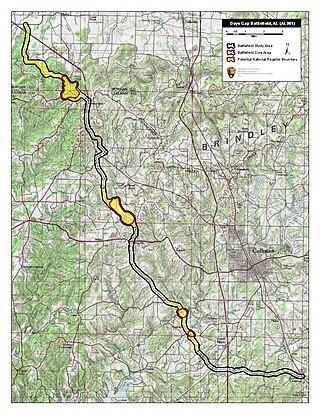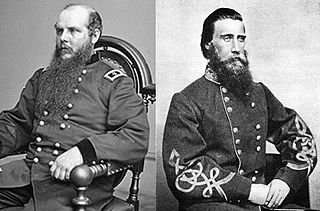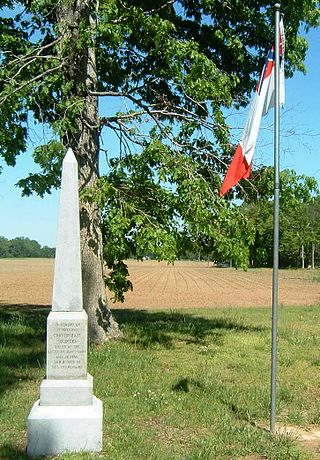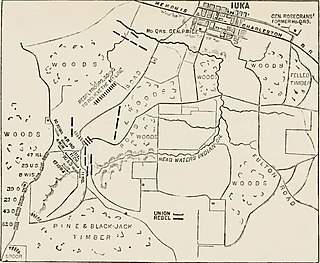
Nathan Bedford Forrest was a Confederate Army general during the American Civil War and was later the first Grand Wizard of the Ku Klux Klan from 1867 to 1869.

The Battle of Brice's Cross Roads, also known as the Battle of Tishomingo Creek or the Battle of Guntown, was fought on Friday, June 10, 1864, near Baldwyn, Mississippi, then part of the Confederate States of America. A Federal expedition from Memphis, Tennessee, of 4,800 infantry and 3,300 cavalry, under the command of Brigadier-General Samuel D. Sturgis, was defeated by a Confederate force of 3,500 cavalry under the command of Major-General Nathan B. Forrest. The battle was a victory for the Confederates. Forrest inflicted heavy casualties on the Federal force and captured more than 1,600 prisoners of war, 18 artillery pieces, and wagons loaded with supplies. Once Sturgis reached Memphis, he asked to be relieved of his command.

The Battle of Stones River, also known as the Second Battle of Murfreesboro, was a battle fought from December 31, 1862, to January 2, 1863, in Middle Tennessee, as the culmination of the Stones River Campaign in the Western Theater of the American Civil War. Of the major battles of the war, Stones River had the highest percentage of casualties on both sides. The battle ended in Union victory after the Confederate army's withdrawal on January 3, largely due to a series of tactical miscalculations by Confederate Gen. Braxton Bragg, but the victory was costly for the Union army. Nevertheless, it was an important victory for the Union because it provided a much-needed boost in morale after the Union's recent defeat at Fredericksburg and also reinforced President Abraham Lincoln's foundation for issuing the Emancipation Proclamation, which ultimately discouraged European powers from intervening on the Confederacy's behalf.

The Battle of Nashville was a two-day battle in the Franklin-Nashville Campaign that represented the end of large-scale fighting west of the coastal states in the American Civil War. It was fought at Nashville, Tennessee, on December 15–16, 1864, between the Confederate Army of Tennessee under Lieutenant General John Bell Hood and the Union Army of the Cumberland (AoC) under Major General George H. Thomas. In one of the largest victories achieved by the Union Army during the war, Thomas attacked and routed Hood's army, largely destroying it as an effective fighting force.

Grierson's Raid was a Union cavalry raid during the Vicksburg Campaign of the American Civil War. It ran from April 17 to May 2, 1863, as a diversion from Maj. Gen. Ulysses S. Grant's main attack plan on Vicksburg, Mississippi.

The Battle of Day's Gap, fought on April 30, 1863, was the first in a series of American Civil War skirmishes in Cullman County, Alabama, that lasted until May 2, known as Streight's Raid. Commanding the Union forces was Col. Abel Streight; Brig. Gen. Nathan Bedford Forrest led the Confederate forces.

The Battle of Columbia was a series of military actions that took place November 24–29, 1864, in Maury County, Tennessee, as part of the Franklin-Nashville Campaign of the American Civil War. It concluded the movement of Lt. Gen. John Bell Hood's Confederate Army of Tennessee from the Tennessee River in northern Alabama to Columbia, Tennessee, and across the Duck River. A Union force under Maj. Gen. John M. Schofield skirmished with Hood's cavalry, commanded by Maj. Gen. Nathan Bedford Forrest, and fortified a defensive line south of Columbia, but soon withdrew north across the Duck River, abandoning the town. Hood's invasion of Tennessee continued as he attempted to intercept Schofield's retreating army at Spring Hill.
The Battle of Brentwood was a battle during the American Civil War on March 25, 1863, in Williamson County, Tennessee at Brentwood, Tennessee.
The First Battle of Murfreesboro was fought on July 13, 1862, in Rutherford County, Tennessee, as part of the American Civil War. Troops under Confederate cavalry commander Brig. Gen. Nathan Bedford Forrest surprised and quickly overran a Federal hospital, the camps of several small Union units, and the jail and courthouse in Murfreesboro, Tennessee. All of the Union units surrendered to Forrest, and the Confederates destroyed much of the Union's supplies and destroyed railroad track in the area. The primary consequence of the raid was the diversion of Union forces from a drive on Chattanooga.
The Third Battle of Murfreesboro, also known as Wilkinson Pike or the Cedars, was fought December 5–7, 1864, in Rutherford County, Tennessee, as part of the Franklin-Nashville Campaign of the American Civil War.

The Battle of Parker's Cross Roads was fought on December 31, 1862, in Henderson County, Tennessee, during the American Civil War.

The Battle of Spring Hill was fought November 29, 1864, at Spring Hill, Tennessee, as part of the Franklin-Nashville Campaign of the American Civil War. The Confederate Army of Tennessee, commanded by Lt. Gen. John Bell Hood, attacked a Union force under Maj. Gen. John M. Schofield as it retreated from Columbia through Spring Hill. Because of a series of command failures, the Confederates were unable to inflict serious damage on the Federals and could not prevent their safe passage north to Franklin during the night. The next day, Hood pursued Schofield and attacked his fortifications in the Battle of Franklin, resulting in severe Confederate casualties.
The Battle of Thompson's Station took place during the American Civil War on March 5, 1863, in Williamson County, Tennessee.

The Battle of Haw's Shop or Enon Church was fought on May 28, 1864, in Hanover County, Virginia, as part of Union Lt. Gen. Ulysses S. Grant's Overland Campaign against Confederate Gen. Robert E. Lee's Army of Northern Virginia during the American Civil War.

The Second Battle of Corinth was fought October 3–4, 1862, in Corinth, Mississippi. For the second time in the Iuka-Corinth Campaign, Union Maj. Gen. William Rosecrans defeated a Confederate army, this time one under Maj. Gen. Earl Van Dorn.

The Battle of Iuka was fought on September 19, 1862, in Iuka, Mississippi, during the American Civil War. In the opening battle of the Iuka-Corinth Campaign, Union Maj. Gen. William Rosecrans stopped the advance of the Confederate Army of the West commanded by Maj. Gen. Sterling Price.

The Battle of Tupelo, also known as the Engagement at Harrisburg, was a battle of the American Civil War fought from July 14 to 15, 1864, near Tupelo, Mississippi. The Union victory over Confederate forces in northeast Mississippi ensured the safety of Sherman's supply lines during the Atlanta Campaign.
Wilson's Raid was a cavalry operation through Alabama and Georgia in March–April 1865, late in the American Civil War. U.S. Brig. Gen. James H. Wilson led his U.S. Cavalry Corps to destroy Confederate manufacturing facilities and was opposed unsuccessfully by a much smaller force under Confederate Lt. Gen. Nathan Bedford Forrest.

The Battle of Okolona took place on February 22, 1864, in Chickasaw County, Mississippi, between Confederate and Union forces during the American Civil War. Confederate cavalry, commanded by Maj. Gen. Nathan Bedford Forrest, faced over 7,000 cavalry under the command of Brig. Gen. William Sooy Smith and defeated them at Okolona, causing 100 casualties for the loss of 50.
Forrest's Expedition into West Tennessee was a raid conducted by Confederate Brigadier General Nathan Bedford Forrest in Tennessee from December 1862 to January 1863, during the American Civil War. Forrest led an expedition of 1,800 to 2,500 men into Union-held West Tennessee to disrupt the supply lines of Major General Ulysses S. Grant, who was campaigning south along the Mississippi River toward Vicksburg.













